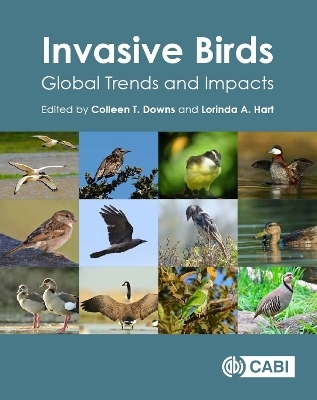
Invasive Birds
CABI Publishing (Verlag)
978-1-78924-206-5 (ISBN)
Examining globally invasive alien birds, the first part of this book provides an account of 32 global avian invasive species (as listed by the Invasive Species Specialist Group, ISSG). It acts as a one stop reference volume; it assesses current invasive status for each bird species, including details of physical description, diet, introduction and invasion pathways, breeding behaviour, natural habitat. It also looks at the environmental impact of each species, as well as current and future control methods. Full colour photographs assist with species identification and global distribution maps give a visual representation of the current known distributions of these species. The second part of the book discusses the biogeographical aspects of avian invasions, highlighting current and emerging invasive species across different regions of the world. The third section considers the impact of invasive species on native communities, problems associated with invasive bird management and the use of citizen science in the study of invasive birds.
Colleen T. Downs (Edited By) Prof. Colleen T. Downs is a South African Research Chair and has been based at the University of KwaZulu-Natal since 1994. Her research interests are broad and interdisciplinary, spanning the conservation, ecology, physiology and behaviour of terrestrial vertebrates with changing land use. This includes ecosystem health in KwaZulu-Natal, incorporating conservation, general biology and persistence of mammal, herpetological and bird species with changing land use (including urban ecology). There is a focus on species such as Cape parrots, bushbuck, oribi, pelicans, Cape vultures, Nile crocodiles, fruit bats, raptors, small carnivores and feral cats. Her other key contribution has been in the development of increased research capacity at both undergraduate and postgraduate levels. Her research group is currently investigating ecosystem health and functionality across a range of taxa and biomes in the Eastern Cape and KwaZulu-Natal Provinces of South Africa, with a focus on species distributions, persistence and anthropogenic threats. They have also produced recommendations for conservation and landscape managers on how best to preserve ecosystem functionality based on sound ecological research. Lorinda A. Hart (Edited By) Dr. Lorinda A. Hart is a lecturer at the University of Namibia and Honorary Researcher at the University of KwaZulu-Natal. Her research interests are broad, covering ecophysiology, and urban and invasive ecology. Her PhD focused on avian and bat frugivores which feed on invasive fruits commonly found in South Africa, quantifying the effects that these frugivores have on invasive seed germination and the energetic rewards they gain. After her PhD she conducted public surveys and determined the current distribution of the rose-ringed parakeet in the in the greater Durban Metropolitan area of eThekwini. She is currently involved in several projects examining a range of species including fruit bats, birds of prey, woolly-necked storks and a variety of seabirds from the Seychelles. She is also an invasive species consultant with the South African Green Industries Council (SAGIC).
1: Introduction Chapter 1: Introduction Chapter 2: Common Starling (Sturnus vulgaris Linnaeus, 1758) Chapter 3: Common Myna (Acridotheres tristis Linnaeus, 1766) Chapter 4: Jungle Myna (Acridotheres fuscus Wagler, 1827) Chapter 5: Red-vented Bulbul (Pycnonotus cafer Linnaeus, 1766) Chapter 6: Red-whiskered Bulbul (Pycnonotus jocosus Linnaeus, 1758) Chapter 7: Great Kiskadee (Pitangus sulphuratus Linnaeus, 1766) Chapter 8: Red-billed leiothrix (Leiothrix lutea Scopoli, 1786) Chapter 9: Ring-necked Parakeet (Psittacula krameri Scopoli, 1769) Chapter 10: Monk Parakeet (Myiopsitta monachus Boddaert, 1783) 2: Global avian invaders (as listed by ISSG) Chapter 11: House Sparrow (Passer domesticus Linnaeus, 1758) Chapter 12: Shiny Cowbird (Molothrus bonariensis Gmelin, 1788) Chapter 13: Brown-headed Cowbird (Molothrus ater Boddaert, 1783) Chapter 14: Rock Dove (Columba livia Gmelin, 1789) Chapter 15: Eurasian Collared-dove (Streptopelia decaocto Frivaldszy, 1838) Chapter 16: Chukar Partridge (Alectoris chukar Gray, 1830) Chapter 17: Cattle Egret (Bubulcus ibis Linnaeus, 1758) Chapter 18: Red Junglefowl (Gallus gallus Linnaeus, 1758), Grey Junglefowl (Gallus sonneratii Temmink, 1813) and Green Junglefowl (Gallus varius Shaw, 1798) Chapter 19: House Finch (Carpodacus mexicanus Müller, 1776) Chapter 20: Common Waxbill (Estrilda astrild Linnaeus, 1758) Chapter 21: Scaly-breasted Munia (Lonchura punctulata Linnaeus 1758) Chapter 22: Northern Red Bishop (Euplectes franciscanus Isert 1789) Chapter 23: Warbling White-eye (Zosterops japonicus Temminck and Schlegel 1845) Chapter 24: House Crow (Corvus splendens Vieillot, 1817) Chapter 25: Australian Magpie (Gymnorhina tibicen Latham, 1802) Chapter 26: Mallard (Anas platyrhynchos Linnaeus, 1758) Chapter 27: Ruddy Duck (Oxyura jamaicensis Gmelin, 1789) Chapter 28: Egyptian Goose (Alopochen aegyptiaca Linnaeus, 1766) Chapter 29: Greylag Goose (Anser anser Linnaeus, 1758) Chapter 30: Canada Goose (Branta canadensis canadensis Linnaeus, 1758) Chapter 31: Mute Swan (Cygnus olor, Gmelin, 1789) Chapter 32: Gray-headed Swamphen (Porphyrio poliocephalus Latham, 1801) Chapter 33: African Sacred Ibis (Threskiornis aethiopicus Latham, 1790) Chapter 34: Great Horned Owl (Bubo virginianus Gmelin, 1788) Chapter 35: Swamp Harrier (Circus approximans Peale, 1848) 3: Avian invaders’ biogeography and emerging invasive species Chapter 36: Continental analysis of invasive birds: Australia and New Zealand Chapter 37: Continental analysis of invasive birds: Africa Chapter 38: Continental analysis of invasive birds: North America Chapter 39: Continental analysis of invasive birds: South America Chapter 40: Continental analysis of invasive birds: Europe and the Middle East Chapter 41: Continental analysis of invasive birds: Asia 4: Impacts and management Chapter 42: Competition between invasive and native bird species Chapter 43: Control or eradication: problems in the management of invasive birds Chapter 44: Using citizen science to study exotic and invasive birds 5: Conclusion Chapter 45: Conclusions
| Erscheinungsdatum | 31.12.2019 |
|---|---|
| Co-Autor | Alexander Cruz, Tim Adriaens, Craig R Allen |
| Verlagsort | Wallingford |
| Sprache | englisch |
| Maße | 219 x 276 mm |
| Gewicht | 1648 g |
| Themenwelt | Naturwissenschaften ► Biologie ► Ökologie / Naturschutz |
| Naturwissenschaften ► Biologie ► Zoologie | |
| ISBN-10 | 1-78924-206-1 / 1789242061 |
| ISBN-13 | 978-1-78924-206-5 / 9781789242065 |
| Zustand | Neuware |
| Haben Sie eine Frage zum Produkt? |
aus dem Bereich


